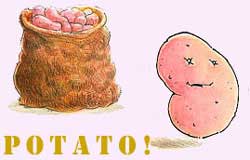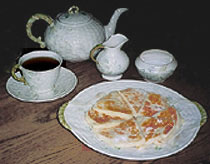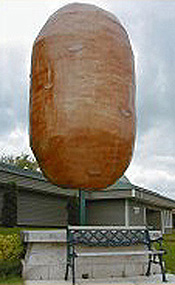|
from 26 august 2001 blue vol II, no 1 edition |
|
|||
|

Artwork: Allan Robinson Over 400 varieties of potatoes are cultivated. Since the 16th Century the potato has become the world's fourth largest food crop (after wheat, corn, and rice). Grown in 128 of 173 nations, its popularity comes from its nutritonal value and versatile productivity. It contains enough carbohydrate, sufficient protein and significant amounts of essential vitamins to meet nutritional needs, which is why a simple dish of mashed potatoes, spring onions and buttermilk was a daily stable for the poor of western Europe during the lean 18th and 19th Centuries. The biological value of potato protein (an index of the nitrogen absorbed from a food and retained by the body for growth and maintenance) is 73, second only to eggs at 96; soy beans are 72, corn 54, and wheat 53. Potatoes are popular because they will grow anywhere, from coastline to lush valley to mountain top, in all kinds of soil, compost and mulches, and under all skies. Potatoes also grow quickly, tubers forming in 60 days, and maturing between 90 and120 days. Native to the Peruvian mountains, the potato was brought to Europe by the Spaniards and first grown in Spain in1570. Within 175 years, by the middle of the 18th Century, it had become the staple subsistence food of every European country, sadly, in Ireland, contributing to a famine that reduced a population dependent and thriving on potatoes from nine to six million during the 19th Century, at least a million starving to death. .
Prince Edward Island Potato Museum So if you have a patch of ground grow your own. Potato bean cakes Overnight soak a cupful of beans. Cook in about three times the amount of water (see cooking methods for beans) until the beans are soft. Mash with a little of the cooking water and set aside. Steam a dozen small potatoes, mash and set aside, keeping any water left over. Mix both together in a large bowl. Place a tablespoon of olive (or sunflower) oil in a pan or wok and when hot but not smoking fry a teaspoon of fenugreek seeds and two small dried chillies. Don't let them turn black. Remove with a slotted spoon and add to your bean/potato mix. In the remaining oil fry a few cms (or half an inch) of root ginger cut into thin slices until golden. Turn the heat down and stew two cloves of crushed garlic until soft. Add to the potato/bean mixture. Combine (depending on availability) one tablespoon of tahini, one tablespoon of barley/rice miso, two tablespoons of peanut (or walnut or almond) butter and a bunch of fresh basil leaves in a mug of boiled water. Mix well and add to the bean/potato mixture. Add some sesame oil to the mixture and blend with a wooden spoon. Add enough flour to make the mixture into a pliable dough. Roll out and cut into squares and bake in an oven set at 180C/360F/Gas5.

Potato Farls:
Bake six
large potatoes in a medium oven, making sure the skins do not blacken. Scoop
out the cooked potato and keep the skins (to fry later). Mash potatoes with coconut or
soya milk or vegetable stock and a teaspoon of sesame oil. Add flour, a small pinch of
seasalt, make into a flexible dough. Roll and cut into half inch thick rounds. Bake in a
hot oven for 15 minutes.
|
|||
| Index |
Next |

 "Collectors of the curious will be pleased to find the giant sculptured potato at the entrance to the museum.
This giant potato is made of fiberglass and stands 14 feet high and is 7 feet in diameter. This is a very
popular spot for picture taking."
"Collectors of the curious will be pleased to find the giant sculptured potato at the entrance to the museum.
This giant potato is made of fiberglass and stands 14 feet high and is 7 feet in diameter. This is a very
popular spot for picture taking."